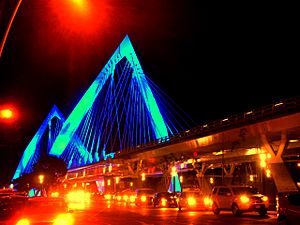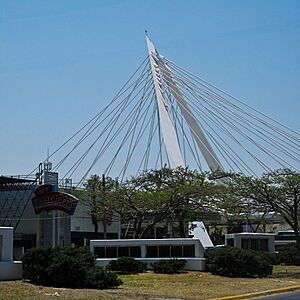Matute Remus Bridge facts for kids
Quick facts for kids Matute RemusPuente Jorge Matute Remus |
|
|---|---|
 |
|
| Carries | Motor vehicles |
| Crosses | Jorge Matute Remus |
| Locale | Guadalajara in Jalisco, Mexico |
| Official name | Matute Remus |
The Matute Remus Bridge is a special type of bridge called a cable-stayed bridge. It is located in the state of Jalisco, Mexico. This bridge is part of a bigger system of bridges on the Lázaro Cárdenas road. This road meets López Mateos avenue, which is one of the busiest streets in Guadalajara. The bridge helps traffic move smoothly through the four main parts of the Guadalajara metropolitan area. Thanks to this bridge, the Lázaro Cárdenas road became a faster highway with fewer traffic lights. The bridge is named after a civil engineer named Jorge Matute Remus. He was famous for moving a large telephone building in the city.
Contents
History of the Bridge
The city of Guadalajara has two main roads that cross it. Where López Mateos and Lázaro Cárdenas avenues meet, there used to be a big traffic problem. More than 200,000 vehicles would get stuck there every day. This made the area very crowded and sometimes unsafe for people walking.
To fix this, the government of Jalisco decided to build a highway where traffic could flow without stopping. This project was part of their "Jalisco State Development Plan 2030."
Building the Matute Remus Bridge
The Jalisco government held a competition to find the best design for the bridge. Architects Miguel Echauri and Álvaro Morales from Metroarquitectura won the contest.
Before building, many things were checked. They looked at how the bridge would affect traffic, the environment, people, the economy, and the city itself.
The Matute Remus Bridge and the Alamo Bridge helped make Lázaro Cárdenas a road where traffic moves easily.
The Lázaro Cárdenas-Vallarta Highway
This highway goes through four main parts of the Guadalajara Metropolitan Area. It starts near the Zapotlanejo highway and ends on the road to Nogales. It has 25 overpasses and elevated sections. These include places like Tonaltecas Avenue, Patria Oriente Avenue, and of course, the Matute Remus Bridge.
Bridge Design
The architects who designed the Matute Remus Bridge wanted it to be more than just a road. They wanted it to be like urban art. They designed a cable-stayed bridge that looked new and different from old highway bridges. This design showed that the designers and builders could create something modern.
The main part of the bridge that hangs is very strong. It needs to hold the whole structure together. But its shadow does not harm the trees below, because the street is mostly open. The design of the Matute Remus bridge is very pleasing to look at. You can enjoy its structure even when you are walking or driving underneath it.
The bridge is modern and useful. It has a park area under it and a new sports area. It also made the city look better by hiding wires. It helped create more open spaces for people to enjoy.
It is also special because it is the only cable-stayed bridge that does not cross over water.
An Illuminated Bridge
The architects also thought about how the Matute Remus Bridge would look at night. They created a special lighting plan. The lights can change color and brightness. This shows off the different parts of the bridge, like the park, the road, and the elevated section. The lighting makes the bridge stand out as an important part of the city.
The bridge was a finalist for the "Urban Public Works" 2011 award by Works Magazine.
Construction Process
Once the design was approved, building the bridge took about one year and four months. Work officially started on September 28, 2009.
Getting Ready to Build
Before building, many things had to be done. This included getting permits, clearing the area, and setting up temporary water and electricity.
During this time, the construction area was marked off. Traffic on the main Lázaro Cárdenas highway was moved to side roads.
The construction was planned in six steps:
- Building ramps and moving trees (21 weeks).
- Building support piles for the fixed bridge (21 weeks).
- Building foundations for the bridge (8 weeks).
- Putting together the fixed bridge structure (36 weeks).
- Putting together the parts of the Matute Remus bridge (20 weeks).
- Improving the look of the city, adding green areas, and pedestrian spaces (12 weeks).
How the Bridge Was Built
The bridge was designed using steel and concrete together. This allowed many parts to be made in workshops. Combining these materials made the bridge very strong. Steel, for example, allows for longer sections with less slope. Most of the work was done on the ridge of the avenue. This helped reduce problems for drivers and people living nearby.
Parts of the Road System
The road system has two parallel bridges. They are 5 meters apart, which lets light pass through. They connect with a 165-meter cable-stayed section. This section makes the whole system work as one unit.
Tension Cables
The strong cables that hold up the bridge were made in Spain. They are made of high-density material and have galvanized cables inside. These cables are designed to last at least 40 years. They can hold up to 340 tons. In most cable-stayed bridges, the bridge deck is connected directly to the support piles. But on the Matute Remus bridge, the deck is separate from the supports. This allows for special dampers to be used to absorb movement.
The road system has three main parts:
- The eastern part: a ramp 122 meters long, 26 meters wide, and up to 7.10 meters high.
- The western part: a 119-meter ramp that connects to another 400 meters of road. This then connects to the hanging part.
- The hanging section: 165 meters long, supported by 78 cables or braces.
The total length of the bridge is 930 meters, and it is 26 meters wide. It has three lanes for traffic in each direction. About 200,000 vehicles are estimated to use it every day.
Environmental Care
From the start, the bridge was planned to be good for the environment. For every tree that was cut down, five new native trees were planted. This was part of a reforestation effort to bring back green areas.
The project ended with 1200 new trees in the area. This was thanks to a program that encouraged people to plant and adopt trees.
Challenges During Construction
Some groups of citizens and neighbors were against building this bridge. They had several reasons. They felt there wasn't a full plan for how people would move around the city. They also worried about the cost and that the bridge was built without asking citizens first. Some groups started a campaign called "Pass it AUN better" to share their concerns.
Public Involvement
In Jalisco, groups of citizens are becoming more involved in government decisions. They want to make sure government actions are good for the community.
The government tried to get public support for the Matute Remus Bridge. They shared information with people and created ways for them to talk about the project. This helped them reach agreements and work together on the complex project.
See also
 In Spanish: Puente Matute Remus para niños
In Spanish: Puente Matute Remus para niños


